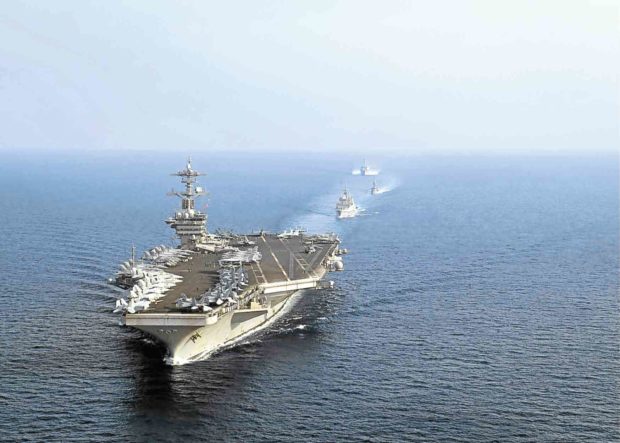US defense exec to PH: We’ll be your good ally in disputed sea

MARITIME SECURITY The aircraft carrier USS Theodore Roosevelt, seen in this photo leading a formation of US and Singapore Navy ships during an exercise in the South China Sea in April, was deployed to the US 7th Fleet for maritime and security operations in the region. US Assistant Secretary of Defense Randall Schriver on Thursday said Washington would be “a good ally” to Manila in its territorial conflicts in the South China Sea. —AFP
The United States will be “a good ally” to the Philippines in responding to territorial conflicts in the South China Sea, a US defense official said.
Randall Schriver, assistant secretary of defense for Asian and Pacific security affairs, gave the assurance as tensions rise over China’s aggressive stance toward its claims to most of the strategic waterway.
Schriver, who spoke on Thursday to reporters at the US Embassy in Manila, was asked if the United States, which is bound to the Philippines by a mutual defense treaty, would help the country if China invaded the main Filipino-occupied island in the South China Sea.
“We’ll be a good ally … there should be no misunderstanding or lack of clarity on the spirit and the nature of our commitment,” he said.
“We’ll help the Philippines respond accordingly,” Schriver added, declining to give further details.
Article continues after this advertisementChina and the Philippines, along with several other Asian nations, have conflicting claims to parts of the South China Sea, which is believed to contain vast mineral resources.
Article continues after this advertisementHowever, since he took office in 2016, President Duterte has moved the Philippines closer toward China and Russia and away from its traditional ally, the United States. He has accused Washington of hypocrisy and bullying for criticizing his brutal war on drugs.
China has built up heavily defended artificial islands in the South China Sea, and Philippine observers have expressed concern in recent weeks over aggressive Chinese radio warnings to foreign planes approaching them.
‘Likely training for strikes’
As Schriver spoke with journalists in Manila, the Pentagon released a report in Washington saying China’s military has expanded its bomber operations in recent years while “likely training for strikes” against the United States and its allies.
The report said that while the People’s Liberation Army (PLA) had continued to extend operations, it was not clear what message Beijing was seeking to send by carrying out the flights “beyond a demonstration of improved capabilities.”
“Over the last three years, the PLA has rapidly expanded its overwater bomber operating areas, gaining experience in critical maritime regions and likely training for strikes against US and allied targets,” the report said.
Beijing at center of strategy
This year, China’s Air Force landed bombers on islands and reefs in the South China Sea as part of a training exercise in the disputed region.
In January, the Pentagon put countering Beijing, along with Russia, at the center of a new national defense strategy.
The Pentagon report said that despite a projected slowdown in economic growth, China’s official defense budget would be more than $240 billion by 2028.
The Pentagon report also said China’s space program was progressing rapidly.
“The PLA continues to strengthen its military space capabilities despite its public stance against the militarization of space,” it said.
This month, President Donald Trump’s administration announced an ambitious plan to usher in a new “Space Force” as the sixth branch of the military by 2020.
High tensions over trade
One of the arguments in favor of developing such a force is that American rivals like China appear increasingly ready to strike US space-based capabilities in the event of a conflict.
The assessment, which comes at a time of heightened US-China tensions over trade, was contained in an annual report that highlighted China’s efforts to increase its global influence.
China and the United States plan to hold trade talks, offering hope they might resolve an escalating tariff conflict that threatens to degenerate into an all-out trade war. —REPORTS FROM AFP